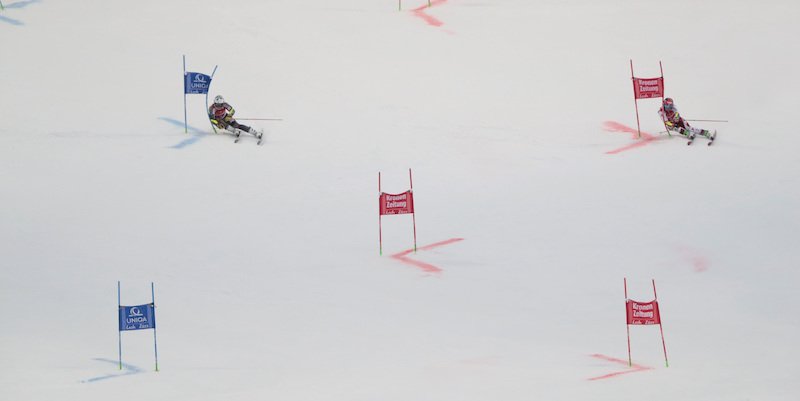Loading player
Parallel slalom is the discipline of skiing in which two male or female skiers descend simultaneously, side by side, on short courses of giant slalom, which is the discipline halfway between the special slalom, in which the poles are very close, and the supergiant. Parallel slalom races are highly televised and easy to follow even live: in fact, they are often enthralling sporting duels for those who watch them and stimulating for those who find themselves doing them, with round of 16, quarter-finals, semi-finals and finals. They also take place on short routes with the individual tests lasting just about thirty seconds.
Put like this, parallel slalom (which is also the discipline of mixed team competitions) seems to have everything to be successful, even among those who follow alpine skiing little. Instead, it is considered minor and secondary to races such as downhill or special slalom. This is because it is too hybrid, because it is not Olympic (except for the mixed race) and because it is almost absent in the World Cup and snubbed at the World Cup.
The rules and formats have changed several times over the years, but parallel slalom still looks set to disappear. Yet he had started as best he could not. In March 1975 it debuted as the last race of the Ski World Cup, the seasonal competition that awards the so-called “crystal cup”. The season ended with two races in Val Gardena, in South Tyrol. After the penultimate race, a downhill, in the men’s general classification there were three skiers with equal points: the Italian Gustav Thoeni, the Swede Ingemar Stenmark and the Austrian Franz Klammer.
Everything was decided in the last race: the parallel slalom which, moreover, the organizers in Val Gardena had agreed to organize rather reluctantly and only on condition that the downhill was also assigned to them. As told by Lorenzo Fabiano in the book Thoeni vs Stenmark, the last goal, the slalom was thought to be a sort of final catwalk, a mostly demonstrative event of a new discipline. Instead, he ended up deciding that World Cup, in front of tens of thousands of live spectators and with millions of viewers for the live broadcast by Rai.
As the most witty have already guessed from the title of the book, in the parallel slalom Klammer, a great downhill skier but not a slalom skier, immediately came out; thus left 24-year-old Thoeni and 19-year-old Stenmark, who still had to score the majority of his 86 victories. The two came to play for the crystal cup in the final, against each other: Thoeni won.
After that grand finale, the parallel was revived a few times, without ever getting close to the results of 1975 and often in demonstration events instead of races valid for the World Cup, to which it returned permanently only from the 2010/2011 season. At the World Cup, which takes place every two years in a different location, the male and female parallels instead arrived only in 2021 in Cortina d’Ampezzo, in Veneto. In the 2022/23 World Cup, the scheduled parallel slalom races were one for men and one for women: both canceled due to lack of snow.
At the Alpine Ski World Championships in 2023, organized in Courchevel and Méribel, those absent from the parallel races included Mikaela Shiffrin and Marco Odermatt, the two best active skiers, as well as most of the male and female skiers in the top positions of the general rankings of the World Cup. Partly because it is considered minor, partly to rest (the individual descents are short, but there are two for each challenge and if added together they become many) and partly to concentrate on the final races of the World Championships, many have chosen not to participate in the parallel.
The German Alexander Schmid and the Norwegian Maria Therese Tviberg won the gold in the men’s and women’s parallel slalom: they are both 28 years old and neither of them had ever won a race at the World Championships or in the World Cup before (and Tviberg was not even never finished on the podium in a non-team race).
Come told and The Team, parallel slalom can be considered a discipline “in danger of extinction”, and even the International Ski Federation is “well aware of its unattractiveness”. A similar end, for not too different reasons, could also befall the combined, a discipline introduced in the 1970s which alternates a speed test with a more technical one, and which often – when there is one – is chosen by athletes just as a form of training.
Meanwhile, however, parallel slaloms remain medal-awarding events, and will ultimately count as much as those in the downhill or special slalom.
– Read also: What future do ski resorts have?
